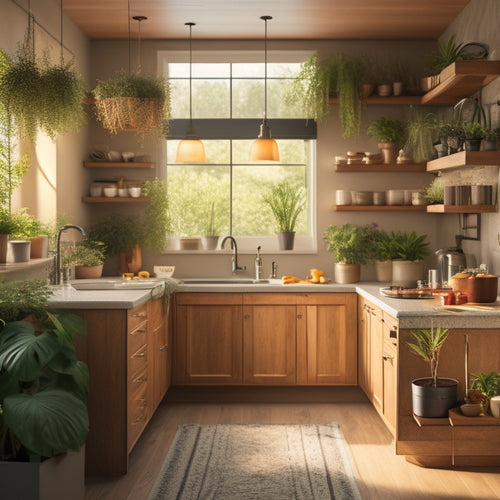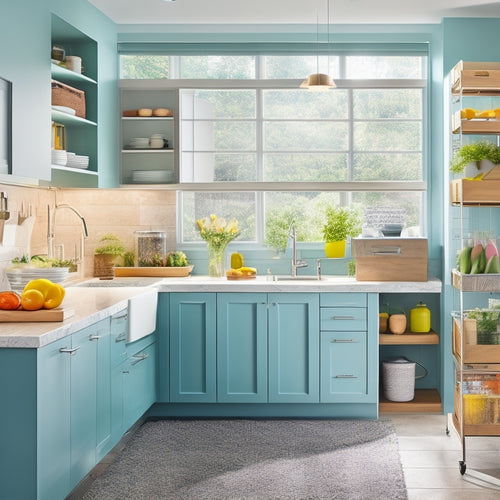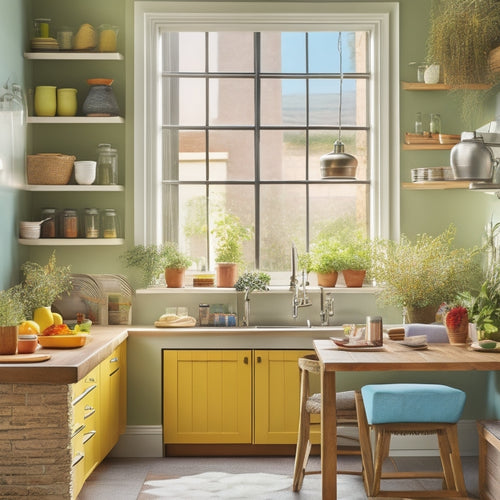
What's Holding You Back From a Clutter-Free Kitchen?
Share
You're stuck in a cluttered kitchen, and it's not just the countertops that are holding you back. It's the emotional attachment to possessions, fear of letting go, and lack of storage solutions. Maybe you're feeling overwhelmed, unsure of where to start, or struggling to set clear goals for your ideal kitchen. Perhaps it's limited space, inefficient workflow, or poor kitchen design that's got you stumped. Or, maybe it's the pressure to live up to unrealistic expectations. Whatever it is, getting past these hurdles is key to achieving a clutter-free kitchen that works for you - and the good news is, you're just a step away from accessing the solutions.
Key Takeaways
• Emotional attachment to possessions and memories can hinder decluttering progress in the kitchen.
• Inadequate storage solutions and poor space utilization can lead to clutter accumulation.
• Unrealistic expectations and societal pressures to achieve a perfect kitchen can cause overwhelm and procrastination.
• Lack of clear goals and vision for a clutter-free kitchen can make it difficult to stay motivated and focused.
• Ineffective time management and decision-making skills can prevent individuals from making progress towards a clutter-free kitchen.
Fear of Letting Go
As you stand in your cluttered kitchen, surrounded by the remnants of last night's dinner and yesterday's mail, your fear of letting go of the items that no longer serve a purpose likely stems from the emotional attachment you've formed with these possessions.
You might think, 'What if I need this someday?' or 'This was a gift from a loved one.' But the truth is, holding onto these items is hindering your decluttering progress.
Your fear is rooted in the emotional attachment you've formed with these possessions. You're not just letting go of an item; you're letting go of a memory or a sense of security. But, embracing a minimalist lifestyle can be liberating. It's about living intentionally, not impulsively.
Ask yourself, 'Does this item bring me joy or serve a purpose?' If not, consider letting it go. Remember, the memories and emotions attached to these items will always be with you, even if the item itself is gone.
Lack of Storage Solutions
Having insufficient storage solutions in your kitchen can result in clutter accumulation, leading to challenges in maintaining organization and control. Without a functional storage system, you may find yourself constantly combating clutter, which can be overwhelming and stressful. To address this, evaluating your kitchen's storage needs and implementing effective solutions is crucial.
Here are three key areas to focus on:
-
Maximize your cabinets: Enhance your cabinet space by utilizing dividers, baskets, or shelves to arrange your kitchen essentials. This will assist in keeping items off countertops and hidden from view.
-
Employ pantry solutions: Consider investing in a pantry organization system or utilizing baskets and bins to classify and store food items, cooking supplies, and other kitchen necessities.
-
Utilize vertical space efficiently: Incorporate shelves, hooks, or a pegboard to optimize your kitchen's vertical space, ensuring that frequently used items are easily accessible.
Kitchen Organization Overwhelm
You're likely no stranger to feeling overwhelmed when faced with the challenging task of organizing your kitchen, a space that's supposed to be a haven for culinary creativity. This overwhelm can stem from poor time management, where you're unsure where to begin or how to allocate your time effectively. As a result, you may find yourself procrastinating, leaving your kitchen in disarray.
Another contributor to kitchen organization overwhelm is decision fatigue. With so many options for storage solutions, decor, and layouts, it's easy to get bogged down in the decision-making process. This mental exhaustion can lead to analysis paralysis, causing you to put off tackling your kitchen organization project altogether.
To combat this, break down your project into manageable tasks, focusing on one area at a time. Set a timer for a specific amount of time, say 20 or 30 minutes, and work on that task without any distractions during that time.
This technique is called the Pomodoro Technique and can help you stay focused and avoid burnout. By tackling your kitchen organization project in bite-sized chunks, you'll be more likely to make progress and achieve your goal of a clutter-free kitchen.
No Clear Goals or Vision
Before you start organizing your kitchen, define what a clutter-free kitchen means to you, and what benefits it will bring to your daily life, as unclear goals can lead to a lack of direction and motivation. Having a clear vision of your ideal kitchen will help you stay focused and motivated throughout the organizing process.
To set your goals, ask yourself:
- What do I want to achieve in my kitchen?
- Do you want more counter space?
- A peaceful cooking environment?
- A place where your family can gather?
- How will a clutter-free kitchen improve my daily life?
- Will it save you time?
- Reduce stress?
- Make meal prep more enjoyable?
- What small steps can I take to get started?
- Create a vision board.
- Start decluttering one area at a time.
- Set aside 10 minutes a day to organize.
Limited Kitchen Space
Limited kitchen space can be a significant obstacle to achieving your ideal kitchen, but by strategically utilizing every available inch, you can create a more efficient and functional cooking environment. One way to do this is by implementing creative solutions that maximize your kitchen's vertical space. Consider installing shelves, hooks, or a pegboard to store frequently used items, keeping them off countertops and freeing up valuable floor space.
Another approach is to adopt space-saving strategies, such as using compact appliances, nesting bowls, and collapsible containers. These items take up less room than their traditional counterparts, allowing you to make the most of your kitchen's limited real estate.
Additionally, think about the 'dead' spaces in your kitchen, like the area above your cabinets or inside a kitchen island, and find ways to utilize them. By being intentional with your kitchen's layout and storage, you can create a more organized, clutter-free space that makes cooking and serving others a breeze.
Online Kitchen Organization Accountability
As you've optimized your kitchen's physical space, now it's time to explore the digital tools and online resources that can help you stay on track with your organizational goals.
The internet offers a wealth of opportunities for virtual support and community engagement, which can be a powerful motivator in maintaining a clutter-free kitchen.
Here are three ways to leverage online resources for kitchen organization accountability:
-
Join online kitchen organization groups: Connect with others who share your goals and challenges. These groups often provide valuable resources, tips, and encouragement to help you stay on track.
-
Take online courses or workshops: Invest in yourself and learn new skills and strategies for maintaining a clutter-free kitchen. These courses often include accountability partners or coaches to help you stay motivated.
-
Find an accountability partner or coach: Share your goals and progress with a friend or mentor who can provide regular check-ins and support. This can be a great way to stay motivated and overcome obstacles.
Inefficient Kitchen Workflow
By streamlining your kitchen workflow, you can dramatically reduce the time and effort spent on meal prep, cooking, and cleaning, freeing up more time for the things you enjoy.
Think about it: when you're cooking for others, you want to focus on the love and care you're putting into the meal, not the chaos and stress of a disorganized kitchen.
To optimize your workflow, start by identifying the tasks that take up the most time and energy. Are you constantly searching for ingredients or utensils? Do you find yourself re-washing dishes because they weren't cleaned properly the first time?
Poor Kitchen Design Layout
You're likely familiar with the frustration of navigating a kitchen where the layout hinders rather than helps your workflow. A poorly designed kitchen can lead to clutter accumulation, making it challenging to maintain a clean and organized space.
To overcome this obstacle, evaluating your kitchen's layout and pinpointing areas for improvement is crucial.
Here are three common kitchen design flaws that might be contributing to your clutter:
-
Inadequate functional storage: If your kitchen lacks ample storage, you may end up using countertops and tables to store your belongings, resulting in clutter.
-
Insufficient ergonomic design: A kitchen that lacks ergonomic considerations can cause discomfort and fatigue, making it more challenging to keep a tidy and organized space.
-
Poorly planned workflow: A kitchen with a poorly designed workflow can create clutter hotspots, particularly around sinks, stoves, and refrigerators.
Unrealistic Expectations
Having addressed the kitchen design flaws that contribute to clutter, it's time to examine your own role in maintaining a clutter-free kitchen, starting with the unrealistic expectations you may have about how you'll use your space.
You might be putting too much pressure on yourself to achieve a perfect kitchen, one that meets societal standards of organization and cleanliness. This perfectionism pressure can lead to feelings of guilt and frustration when your kitchen doesn't live up to your ideals.
Be honest with yourself - are you falling into the comparison trap, scrolling through social media and feeling like your kitchen doesn't measure up? This self-judgment can be overwhelming and may even prevent you from taking action to declutter and organize your space.
Remember, your kitchen is a functional area meant to serve you and your family, not a showpiece for others. Let go of the need for perfection and focus on creating a space that works for you.
Frequently Asked Questions
How Do I Declutter Sentimental Kitchen Items, Like Grandma's Cookbooks?
"Treasured family keepsakes, like grandma's cookbooks, hold emotional weight, making decluttering tough. You can honor memories by keeping a few select items, digitizing recipes, or passing them to family members, freeing up kitchen space and your heart."
Can a Clutter-Free Kitchen Really Improve My Mental Health?
You'll be amazed how a clutter-free kitchen can reduce stress and boost mental health! By implementing simple organization tips, you'll break the clutter connection and create a peaceful space that nourishes your well-being.
Are There Any Affordable Kitchen Organization Solutions Available?
"You're stuck in a whirlpool of kitchen clutter, but don't worry! You can break free with affordable storage solutions and creative hacks that'll turn your kitchen into a serene oasis, without breaking the bank."
How Often Should I Clean and Maintain My Kitchen Organization Systems?
You'll want to clean and maintain your kitchen organization systems regularly, ideally weekly, to prevent clutter buildup. Set aside time to dust, wipe down surfaces, and put away items, especially sentimental ones, to keep your space organized and functional.
Can I Still Have a Clutter-Free Kitchen With a Small Budget?
Did you know that 75% of people feel overwhelmed by clutter? You can still achieve a clutter-free kitchen on a small budget by opting for budget-friendly organization solutions and embracing minimalist kitchen design principles that maximize space and simplicity.
Related Posts
-

Space-Saving Kitchen Island Storage Hacks
You can change your small kitchen into a functional haven with clever space-saving island storage hacks. Start by ins...
-

Sink Storage Solutions for Open-Concept Kitchens
To maximize storage in your open-concept kitchen, focus on clever under-sink solutions and vertical space utilization...
-

Creating More Space in a Tiny Kitchen
You can alter your tiny kitchen into a more spacious haven by utilizing smart storage solutions. Install wall-mounted...


